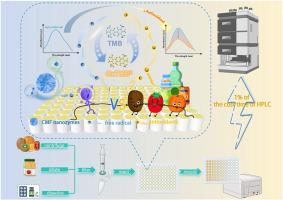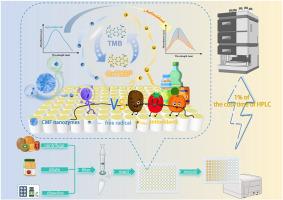Pioneering food analysis: Transformative antioxidant testing with colorimetric assays using Co–Mn bimetallic oxide nanozyme
IF 5.7
2区 化学
Q1 CHEMISTRY, ANALYTICAL
引用次数: 0
Abstract
Background
Total antioxidant capacity (TAC) testing is critical for guiding dietary, and nutritional treatments, and investigating the efficacy of antioxidant food additives.
Results
Here, a competitive enzyme-like colorimetric method based on Co–Mn nanoflower nanozymes was developed for the determination of TAC in food. The synthesized nanozymes had excellent POD-like activity, using the antioxidant as a special recognition unit and the chromogenic substrate as a signal molecule reporter, and could generate a significant color response in less than 15 min by producing enzymatically catalyzed ROS. Antioxidants in food were introduced into the system and inhibited the oxidative attack of reducing substances, which was signaled through signal molecules. The established TAC sensor had a sensitivity response of 1–20 μg/mL and a low detection limit of 0.1 μg/mL. It was worth noting that the developed detection strategy not only meets the criterion of a reduced elapsed time for the HPLC method but also achieves high-throughput batch detection. The examination of each component can be accomplished in 10–20 s while maintaining the same precision as the commercially available HPLC approach.
Significance
The model designed based on simulated enzyme materials is a successful exploration of the application of nanozymes in the field of food quality testing, which will further realize the accurate and comprehensive analysis of TAC in the future.


食品分析的先驱:利用 Co-Mn 双金属氧化物纳米酶的比色法进行变革性抗氧化测试
背景总抗氧化能力(TAC)检测对于指导膳食和营养治疗以及研究抗氧化食品添加剂的功效至关重要。合成的纳米酶以抗氧化剂为特殊识别单元,以发色底物为信号分子报告物,具有良好的类 POD 活性,通过产生酶催化的 ROS,可在 15 分钟内产生明显的颜色反应。将食物中的抗氧化剂引入该系统,可抑制还原性物质的氧化作用,并通过信号分子发出信号。所建立的 TAC 传感器的灵敏度响应为 1 - 20 μg/mL,检测限低至 0.1 μg/mL。值得注意的是,所开发的检测策略不仅符合缩短高效液相色谱法所需时间的标准,还实现了高通量批量检测。基于模拟酶材料设计的模型是纳米酶在食品质量检测领域应用的一次成功探索,未来将进一步实现对TAC的准确、全面分析。
本文章由计算机程序翻译,如有差异,请以英文原文为准。
求助全文
约1分钟内获得全文
求助全文
来源期刊

Analytica Chimica Acta
化学-分析化学
CiteScore
10.40
自引率
6.50%
发文量
1081
审稿时长
38 days
期刊介绍:
Analytica Chimica Acta has an open access mirror journal Analytica Chimica Acta: X, sharing the same aims and scope, editorial team, submission system and rigorous peer review.
Analytica Chimica Acta provides a forum for the rapid publication of original research, and critical, comprehensive reviews dealing with all aspects of fundamental and applied modern analytical chemistry. The journal welcomes the submission of research papers which report studies concerning the development of new and significant analytical methodologies. In determining the suitability of submitted articles for publication, particular scrutiny will be placed on the degree of novelty and impact of the research and the extent to which it adds to the existing body of knowledge in analytical chemistry.
 求助内容:
求助内容: 应助结果提醒方式:
应助结果提醒方式:


